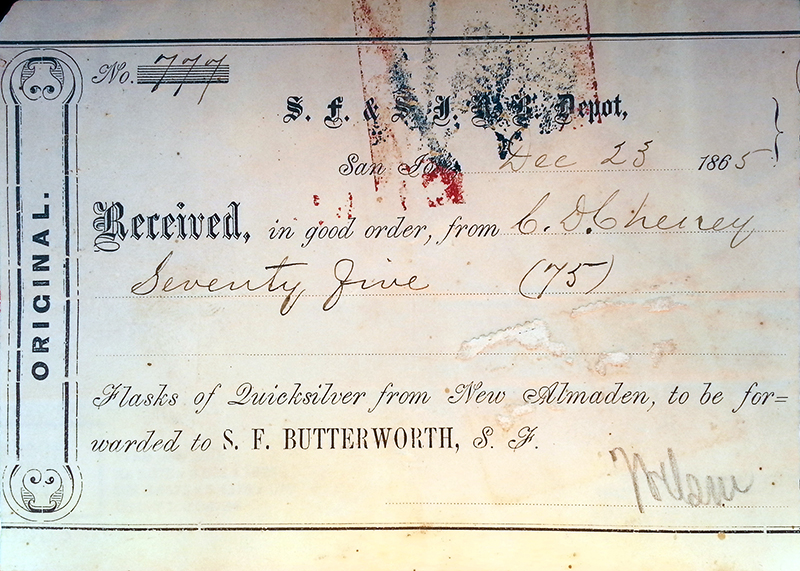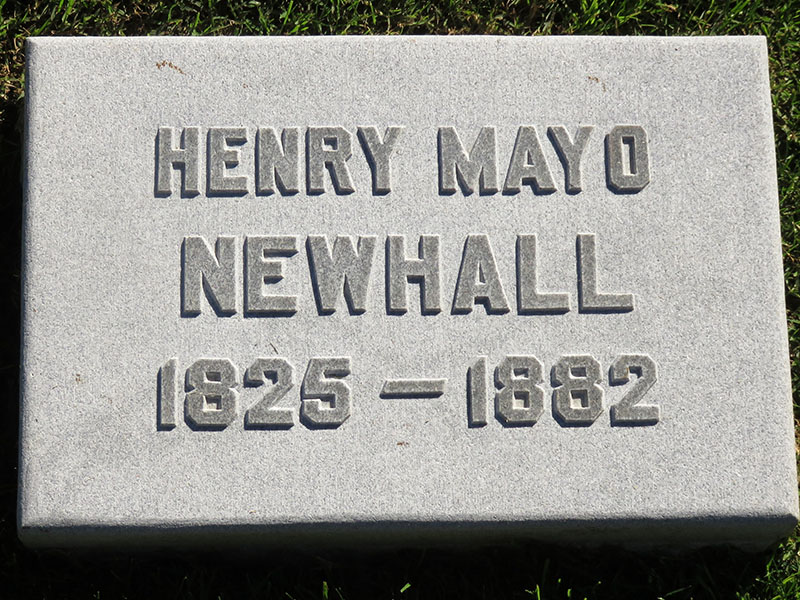|
|
San Jose, California

Click image to enlarge
Receipt (No. 777) from Henry Mayo Newhall's San Francisco & San Jose Railroad Depot (in San Jose, Calif.) for 75 flasks of quicksilver (mercury), December, 23, 1865. Mercury was used in an arrastre or mill to separate gold and silver from the host (quartz) rock. Quicksilver mining at New Almaden (Santa Clara County) began in 1845 when a Mexican cavalry officer, Capt. Andres Castillero, discovered that the red rock used by the local Ohlone Indians to paint their bodies and the walls of the Santa Clara Mission was cinnabar, an ore containing mercury, which was needed to process silver in Mexican mines and gold in California. American companies eventually acquired the mercury mining operation; it continued under the management of Capt. Henry Halleck and became the world's second largest producer of mercury. Turn up the clock to 1973, and the Santa Clara County Parks and Recreation Department began purchasing the abandoned mining properties; in 2011 the Parks Department reopened Halleck's large 1854 home and mining office as the New Almaden Quicksilver Mining Museum. (Source: Santa Clara County Parks.) This receipt is the earliest known document (of two) relating to Henry Newhall's railroad, which was completed in January 1864. Digital images contributed by the owner of the document, Robert Green of Saint Augustine Beach, Florida. Green said he found it inside an old book he purchased — a 19th-century German Bible. Most SCV residents would associate Henry Mayo Newhall with the town he founded on the Rancho San Francisco in the Santa Clarita Valley in 1876. They may not know, however, that Mr. Newhall considered San Francisco his primary home, and in fact spent much of the last half of his life in the Golden Gate city. Although arriving in the Bay Area with literally the clothes on his back during the California Gold Rush, he became a wealthy and prominent citizen of San Francisco through his auction, railroad, and real estate endeavors. In the late 1850s, most of the Bay Area's growth was heading south towards San Jose. Commuters between San Francisco and San Jose had to endure a grueling nine hour stagecoach trip. San Francisco's business leaders began to think about building a railroad between the two cities. Newhall was to become involved in the railroad business after receiving a one-third interest in a railroad company as a consolation prize for having co-signed and paid off a $90,000 note that went into default. Along with partner Peter Donahue, Newhall embarked on a risky venture which would become the San Francisco and San Jose Railroad. He eventually took the post of President of the Railway. Against all odds, and with construction costs exceeding a then enormous sum of $2 million, the tracks between San Francisco and San Jose were to be completed on January 11, 1864. Newhall sponsored a huge celebration that day which included a military parade in San Francisco and free train rides between the two cities. Newhall and Donahue are credited with planning and constructing the first financially successful railroad in California. However, Newhall had even loftier goals in mind. Since the early 1850s, the U.S. Government had been exploring potential routes for a transcontinental railroad to connect the East and West coasts and bring the wagon train era to a close. Newhall wanted to obtain the government contract to build the Western portion of the transcontinental railroad. But the usually successful Newhall met his match when he had to compete against the "Big Four" men of the Central Pacific Railroad. Collis P. Huntington, Mark Hopkins, Leland Stanford, and Charles Crocker would offer Newhall the right to build the last 175 miles of track from Sacramento to San Francisco in exchange for his promise not to interfere with the Central Pacific's lobbying efforts in the Congress. But when the Pacific Railroad Act awarded the contract to the Central Pacific in 1861, the wily Big Four managed to omit Newhall from the last draft. The transcontinental railroad would be completed at Promontory Summit, Utah, on May 10, 1869. Having been pushed aside by the Central Pacific, Newhall decided to try to build another railroad south to San Diego and than eastward through the Southwest. William Ralston, then President of the Bank of California, joined the Board of the SF & SJ Railway, and the two men began planning Newhall's dream to develop another transcontinental line to the South. But once again Newhall was to have his plans dashed by the Big Four. After completing the Central Pacific Railroad, the railroad magnates formed the Southern Pacific Railway and began buying up over one hundred small independent lines in California. They outmaneuvered Newhall by buying stock in the SF & SJ from the city of San Francisco. Knowing he would eventually lose to them again, Newhall sold his railroad to the Southern Pacific in October, 1870. Out of respect for their formidable rival and as part of the deal for purchasing his railroad, the next year the Southern Pacific accepted Henry Mayo Newhall on their Board Of Directors, a position he held the rest of his life. — Alan Pollack
HS6501b: 19200 dpi jpeg from digital image (photograph) April 2015 by Robert Green | Online image only | Original digital image on file. |
H.M.N. CATEGORIES:
Documentary: Story of Henry Mayo Newhall & Newhall Foundation (2015)
Portrait x2
HMN Signature on SF&SJRR Pass, <1870
HMN's Railroad Receipts (2)
5 Sons 1873
Obituary 1882
Reading of Will 1882
Graves of HMN & Heirs, Wyatt Earp, more
Son H.G. Newhall's California Bank
Grandsons George A., Walter Scott 1912
Grandson Almer Calls Argentina 1930
|
The site owner makes no assertions as to ownership of any original copyrights to digitized images. However, these images are intended for Personal or Research use only. Any other kind of use, including but not limited to commercial or scholarly publication in any medium or format, public exhibition, or use online or in a web site, may be subject to additional restrictions including but not limited to the copyrights held by parties other than the site owner. USERS ARE SOLELY RESPONSIBLE for determining the existence of such rights and for obtaining any permissions and/or paying associated fees necessary for the proposed use.












